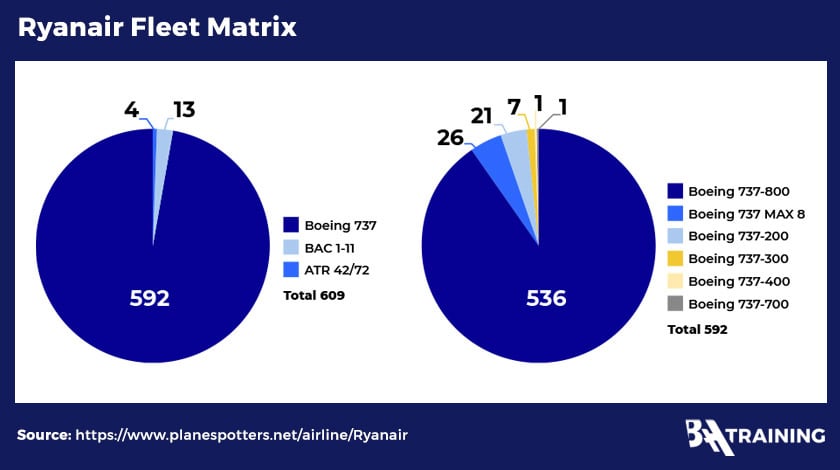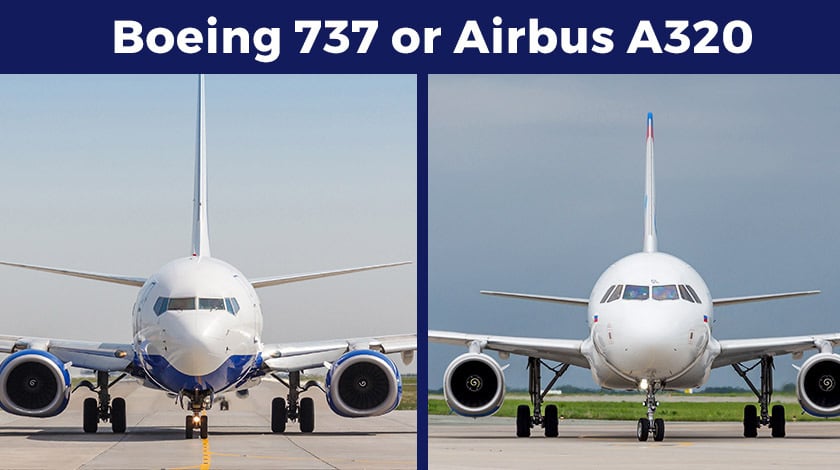Photo: BAA Training
Reading Time: 5 minutesYou can already tell from the heading that the debate is not an easy one. The rivalry between the two dominant manufacturers is one of the most heated in the world. Each of the two aircraft has its strengths and weaknesses, turning a choice between Boeing 737 and Airbus A320 Type Rating training into a mind-breaker. And all of you will most probably have your own “recipe” for giving preference to one or another. Nonetheless, let’s analyze some of the most common factors that make pilots choose one of the two market leaders.
Plane makers’ performance indicators
As both Airbus and Boeing have kept up with each other for many years, performance indicators can hardly be viewed as the sole and most relevant decision-making factor. However, they can give you some background about where the company stands today. Thus, this data might tell you what you can presumably expect in the nearest future.
Due to the pandemic-caused aviation industry slump, both Airbus and Boeing experienced hard times. Their aircraft delivery numbers reflect this very well. In 2020, Airbus delivered 419 Airbus A320 Family aircraft as opposed to 636 in 2019. In contrast, Boeing delivered only 32 Boeing 737 Family aircraft in 2020 versus 116 in 2019.
The numbers, however, should be interpreted in the context of the recent events. In addition to the pandemic shaping the statistical overview, the grounding of the most demanded world’s jet – Boeing 737 MAX – played a significant part. Previously, Boeing was often outselling Airbus, especially up until 2002 and 2014-2016.

Cockpit design philosophies
The companies have very different philosophies about their aircraft. You might have heard somebody claiming that you have more control and feel of what the plane is experiencing when flying on Boeing. And this is right because Boeing has a traditional control wheel, whereas Airbus has a highly automated system and a side stick.
According to Airbus, the absence of the larger yoke ensures much more comfortable flying. It also allows operating the array of computers easier with more space and one free hand. The competitor states that the yoke is an essential tool to handle emergencies. It does not prevent a pilot from overriding the autopilot if necessary and allows for better coordination between the pilot and co-pilot.
Pilots type-rated on both Airbus A320 and Boeing 737 say that it took a while for them to get used to a fundamentally different way to operate an aircraft. However, when they master the techniques, most of them quickly realize the benefits of both. And what about you? Which of the philosophies rings your bell?

Pilot training principles
While both manufacturers name safety as their priority, they ensure it by taking different measures. Boeing advocates for the pilot and not excessive reliance on automation, while Airbus aims to eliminate human error. With this pursuit of eliminating pilot mistakes, Airbus has gone even further than we discussed in the previous paragraph.
In 2007, it started to work on a concept called Evidence-Based Training (EBT). The initiative was supported by other original equipment manufacturers and stakeholders and presented to IATA. It eventually defined a new paradigm for training worldwide, at the core of which lies competency-based training encompassing a combination of both technical and non-technical aspects. The previously disregarded non-technical skills help trained pilots to mitigate the risks of the unpredictable.
Airline specific choice
It is always good to know about different types of aircraft and their characteristics, but a more down-to-earth approach to choosing a Type Rating would start with airline research. In aviation, just like in any other industry, you should think several steps ahead and predict the demand for a specific Type Rating you are about to acquire.
The good news is that both Boeing and Airbus are massively popular almost in every corner of the world. Knowing this, you can already feel a bit more relieved and sure that it will be right whatever choice you make. However, take your time to ask yourself questions about what airline you want to fly or, at least, in what region. It will then be easy to dig deeper and find out what type of aircraft it operates.
A common bias is that Boeing is for Americans, and Airbus is destined for Europeans. Although both have the biggest market share in their home continent, still, if you feel more like flying Boeing while being based in Europe – you have your options. Boeing has delivered 4,600 commercial aircraft to more than 130 European customers in the last 60 years. Google Ryanair’s, Lufthansa’s, or Air France’s fleet details. You will see that all of these airlines (and more in Europe!) operate 592, 130, and 63 Boeing 737 aircraft, respectively, with Ryanair not having a single Airbus A320 airplane. On the other hand, Airbus forms a part of all the most prominent American airlines’ fleets.

Even if you have an airline in mind, do not make an impulsive decision and check if it is hiring, how often it does so, its philosophy and values, and how it compares to your personal preferences and beliefs.
Lifestyle specific choice
It would be fair to say that you choose your life by choosing your future job and employer. You should understand that different types of airlines would not offer the same lifestyle.
For instance, the network airlines that have been in the market since the dawn of aviation will offer you long-haul flights, wider aircraft, and a diversity of routes. It implies that you will be likely to go to hundreds of destinations but at the same time be further apart from your family with rarer chances to reunite. Completing short-haul flights with a regional airline would guarantee you are flying to smaller cities and airports, which are usually easier to get in and out.
Finally, don’t forget that there are airlines that have a completely different model from mainline and regional carriers – ACMI operators. The nice part about being an ACMI pilot is that you usually stay in the place you fly to for a longer time, not just a layover. This way, you can explore unknown places and cultures and have some well-deserved rest there. Working for an ACMI, like SmartLynx or Avion Express, you can experience many different operations: dry lease, wet lease, cargo, and endorse your career this way. Both SmartLynx and Avion Express could consider your candidature if you get an Airbus A320 Type Rating.
Get type-rated at BAA Training
BAA Training that has prepared this advisory type of content offers both Airbus A320 and Boeing 737 Type Rating courses to its clients. With us, you can embark on the last but not least part of your pilot training in a location of your choice. The headquarters in Vilnius, Lithuania, will welcome you with full flight simulators (FFSs) replicating Airbus and Boeing 737 airplanes. A brand-new training centre in Barcelona at the time of writing this article is at the finishing stage of launching the Airbus A320 FFS service. It also expects additional deliveries of Boeing 737 FFSs. Moreover, you can book the Airbus A320 simulator hours in our Vietnam training centre. The company also has a presence in China, with Boeing 737 FFS occupying its BAA Training China premises.
Bottom line
There is no definite answer to which type is right and which is wrong. More precisely, you have to figure it out for yourself. Try to think wisely about which type – Airbus A320 or Boeing 737 – you want to lead you throughout your whole aviation career (or at least for starters). Please do your homework about the airlines, their fleets, recruiting, and see what is in line with your personal goals and interests. Remember that your motivation can be totally different from the reviewed aspects, and you will still hit the point. Maybe you want to fly people on holiday and see their smiley faces. If so – don’t hesitate to put this criterion on the list when selecting your Type Rating!

